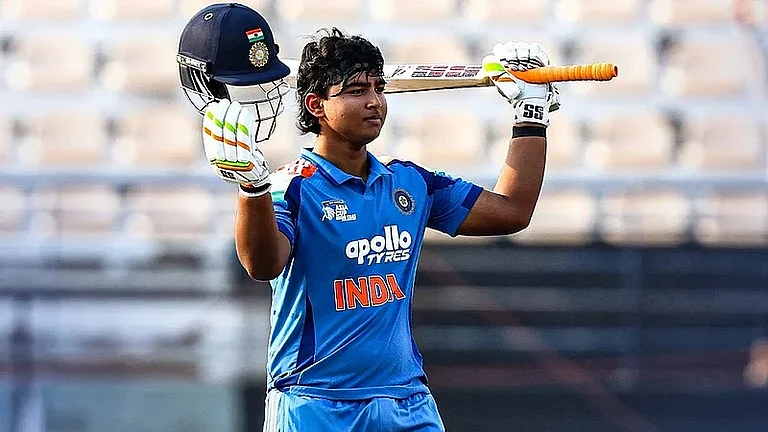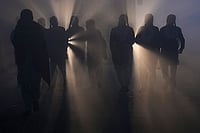The coming year marks the 150th anniversary of the Uprisingof 1857 and the 250th anniversary of the Battle of Plassey. The connection isnot arbitrary, the fighters of 1857 were keenly aware of the significance of thePlassey anniversary and their preachers and ideologues enthusiastically playedup the apocalyptic moment. When we attempt to celebrate these momentous eventsof modern Indian history, however, we are faced with a woeful lack of iconicimages. What do we recall when we think of Plassey, merely the chagrin of defeator worse, the Black Hole. What can we bring to 1857 that will match thestupendous mythology around Kanpur and Satichaura Ghat, the Residency and therelief of Lucknow? There are no episodes of last ditch stands, no display ofindividual heroism and valour, no markers, myths, figures or details on which tohang our fevered imagination. British Imperial mythology on the other hand, whenyou begin to probe it, is often less about glorious victories than accounts ofdefeat and dejection -- think Dunkirk, Khartoum, Kanpur, Black Hole -- whichtells us how the most desperate imperial scare could end up, reworked intofiction, historiography and national myth, actually bolstering imperialself-confidence.
Amongst the most potent of those was the Black Hole. If youask an average Indian, or a Briton for that matter, about the Black Hole today,he is more likely to mention to you the one in outer space. It is a measure ofhow our imaginative landscape and our national mythologies have altered in thelast fifty years. Not too long ago, the Black Hole stood as the most ghastlysymbol of native cruelty and Imperial triumph, of Indian treachery versus thenever-say-die spirit of the British. Taught in school histories, in India andEngland, memorialised in novels, diaries, poems, plays, memoirs and letters --school children in faraway Rhodesia in the 1890s performed plays on it -- theBlack Hole was both event and metaphor, memory and reminder, symbol of disasterand supremacy and while the event has been forgotten, the phrase lives on inpopular usage. Jan Dalley, British journalist and writer, investigates the eventand its afterlife in a new book.
So what was the Black Hole? According to British historian JH Little, writing in 1916, merely a ‘gigantic hoax'. For Lord Curzon, whoerected a new monument to mark it, the same Holwell’s monument which SubhashChandra Bose successfully agitated against shortly before going on exile, it was‘practically the foundation stone of the Brtisih Empire in India’. Dalley’sbook is an attempt to unearth the actual events, to trace how and why itoccurred and to examine the modes by which it has been enshrined in Imperialimagination. It succeeds in the first task, fails in the second and is feeble atthe last.
In June1756, the Nawab of Bengal, Sirajuddaulah, afterpreviously warning the English governors against recent fortifications, marchedfrom Murshidabad and besieged the heavily outnumbered British, including nativesand other Europeans, in Fort William, Calcutta. A few days of fighting later, on20th June, the residents, 146 of them in the consecrated version, werelocked in a tiny cell overnight, and in the morning only 23 emerged. There isalso a sleepy Nawab in the story. When asked what was to be done with theprisoners, Sirajuddaulah answered, let them be locked in their dungeons, that isthe prisoner’s cells built by the British inside the fort. By the morning, whenthe men, women and children began to die of thirst and asphyxiation, the Nawabcould not be woken up and so when the cell was opened, only 23 of them survived.A few months later, in a heroic march, Robert Clive sailed down from Madras, anddefeated the much larger forces of the Nawab in the battle of Plassey that setthe foundation for the British Empire in India.
Every single detail of the event has subsequently beenquestioned and refuted. If the cell was so tiny -- barely six by four in someversions -- how were so many people cramped into it? The only versions we have ofthe event are by the survivors, John Holwell chief amongst them, and theirversions of the number of the people and the conditions of their imprisonment donot tally. But the lurid details of the night ring truer than the truth of theevent: how the survivors asked for water, how it was passed from hat to hat, howin an attempt to fan themselves with their hats, the prisoners bruised andwounded each other, how the gate wouldn’t open in the morning because of thepiled-up bodies and so on.
Dalley is skillful at unearthing the exact sequence ofevents, at matching survivors’ stories with each other and with reconstructingthe way events unfolded in that June week. She concludes that the Black Hole wasa reality (the exact numbers, she concedes, must be impossible to get entirelycorrect although Little claims 6 survivors out of nine prisoners and BritishHistorian Linda Colley counts 8 survivors out of 40), but she does askquestions. "Was it deliberate brutality on the part of the victor, or wasit simply a sad mistake on the part of the nawab's soldiers?" How did thestory prevail in a century packed with bloodshed and massacre on a much granderscale? Why were succeeding generations keen to re-tell it? There is enormousliterature on the Black Hole by Indian historians, most notably in Bengali, andshe would have been able to fill up the Indian side had she consulted them morethoroughly.
But this is a British book, written primarily for Britishaudiences. It is evident in the way she narrates the history of colonialexpansion. East India Company and its trading endeavors are, for her, a searchfor nutmeg, for exotica, ‘the need for a buzz’. In this account ofindividual bravery and risk-taking, there is no place for political economy, forthe fact that there was a massive European expansion in all corners of theglobe, that the world of the Indian Ocean was a thriving metropolitan scape ofdiverse nations, tongues, and peoples, that until the 18th century, the Indianmerchants dominated trade bound to and from India far more heavily thanEuropeans, that they had credit and financial mechanisms that extended up toAfrica.
In this book about 18th century Europe, the word 'mercantilism', which defines linkages between commerce, politics and stateformation, does not find a single mention. Her account of Indian history -- the18th century has perhaps seen more fundamental research than any other centuryin the last twenty years -- could have been lifted straight from an Imperialaccount, V A Smith’s for instance, since it casts the Mughals as the principalplayers, as Muslim rulers ‘in alliance with a Hindu merchant class’ againsta ‘largely antagonistic Hindu populace’ to boot. She informs us, a numberof times, about how Sirajuddaulah hated the British but does not bother to askwhy. Siraj’s cunning and ambition receives flak but praise for his informationand communication system -- he had knowledge of the minutest developments ofCalcutta, thirty hours away from Murshidabad -- is not analysed for itssignificance.
Dalley seems, also, to have imbibed uncritically earlyBritish fancies about the greed of the Oriental monarchs. She talks about the‘massive wealth generated by the foreigners’ for indigenous rulers (on pp.102, 103, 107), entirely unmindful of the fact that for rulers like AlivardiKhan, Siraj’s uncle and the previous Governor, the Mughal Emperor was morethan a fossil and that is why he continued to send annual tributes of upwards of20 lakhs for as long as he reigned. And then, while describing the Britishactions, she provides us this masterly exculpation: ‘it was not a very Britishway of doing things.’
There are nice nuggets along the way, about men like ElihuYale, a Governor of Madras and the future founder of the Ivy League universityof that name, about Thomas Pitt, the grandfather of the future Prime Minister,and the diamond named after him, about the curious fashion for using brass doorknobs in hot Calcutta, which would have to be changed to marble ones in thesummer. So the memory of rapes at Kanpur in 1857, which certainly did not occur,spurred and justified cruelty in the aftermath of that war and the memory ofBlack Hole threw, as Nirad Chaudhry puts it, ‘a moral halo over Britishconquest of India,’ just as the Jallianwala Bagh became a sacred memorial forenvisioning and creating the Indian national. Myths are important for Imperialaggrandisement as much as for anti-colonial resistance, so why is there no mythsurrounding Sirajuddaulah’s grand march to Calcutta or the mutineers’bravery in 1857? It would not be enough to say that History is written byvictors for now, we, the heirs of the colonial state, are victors overcolonialism too.
Dalley starts her book by reminiscing over her childhood inIran where her father worked for British Petroleum and wonders at the differencebetween his actions and that of the East India Company. According to NickRobbins there is none. A blistering critique of the greed inherent in acorporation, Robbins’ book examines the foundation, development and afterlifeof the Company by seeing it as the forerunner, a hugely formative one, of themodern multi-national Corporation. He takes us back to the worlds of EdmundBurke and Adam Smith, of the pamphlets and plays of 18th Century which excoriated the company and feared that itsgreed and its monies would corrupt England just as territorial acquisitionwould, for Burke, whose rehabilitation is a strong achievement of this book,wholly compromise the equality between peoples, and thus England’s politics,forever.

| The Corporation that Changed the World : How the East India Company Shaped the Modern Multinational by Nick Robbins, Orient Longman, 218 pages, Rs 295 |
Eventually, however, both these books by British journalistscum writers are really about Britian, where India is a peripheral player. ThatDalley sees the Empire as a creation of young men in search of adventures andRobbins explains it as the power of the corporation tells us, eventually, moreabout their particular locations in British society than about Indian history orthe Empire.
Mahmood Farooqui is a Delhi-based freelance writer and performer. A shorterversion of this appeared in the print edition.























